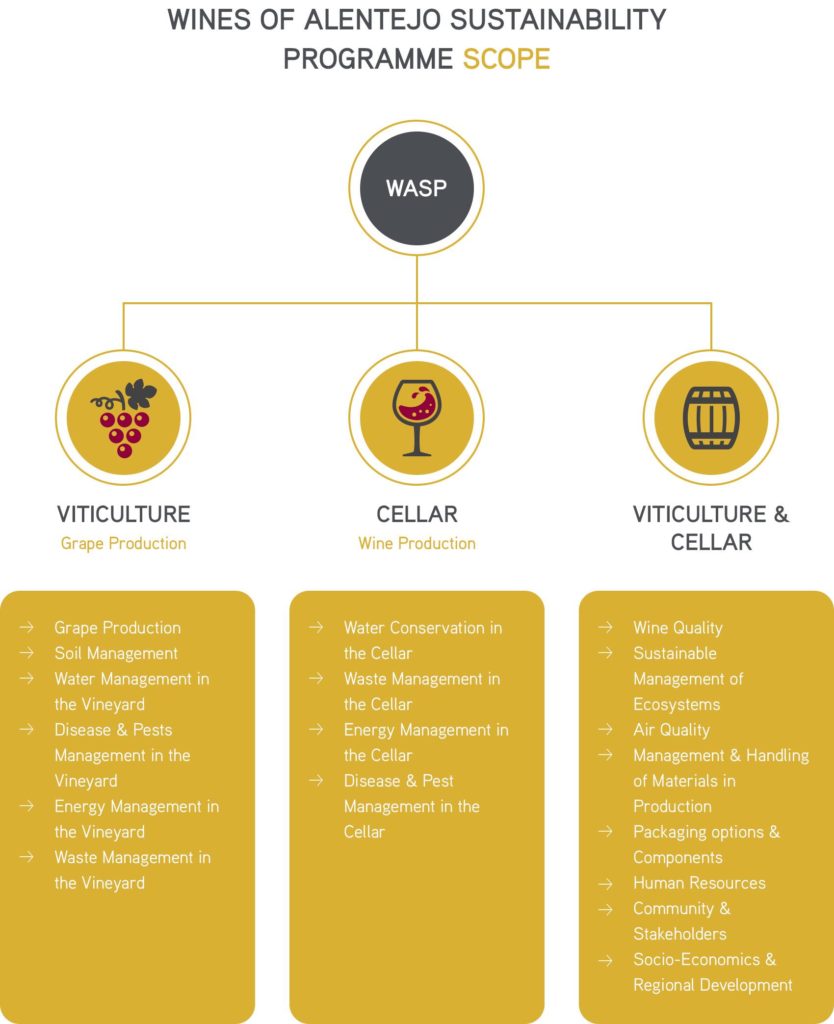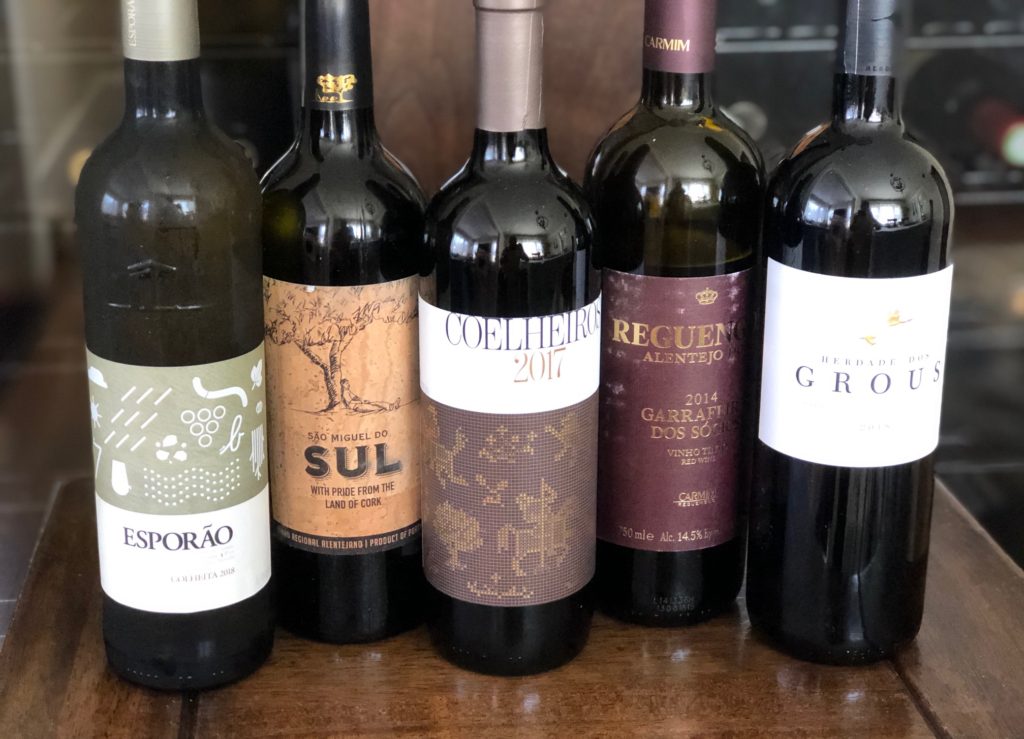“Sustainability is the new paradigm of the 21st century. Producers who do not make sustainability a core part of their business model will become progressively outdated, side-lined by consumers and, possibly, through new international policies.”
João Barroso, Sustainability Coordinator, Wines of Alentejo
Over the past year or so, I’ve participated in a few educational, and sample programs featuring the wines of Alentejo. I must say I’ve been very impressed with quality and value the wines offer. These are most definitely wines you should know and look for.
Most recently, I participated a webinar to learn more about the Alentejo’s internationally recognized and award winning sustainability program (“WASP”) Therefore, I’ve chosen to make that the focus of Part 1, of what will be a two-part series about Alentejo wine.
About Alentejo
The Alentejo (ah-len-TAY-zhoo) is located in southern Portugal. It’s a sizable region about the size of the state of Massachusetts, that covers about a third of the country. It has a long history as a major producer of grains and corks. In fact, nearly half of the world’s supply of corks is sourced from the region’s cork oak trees
Winemaking in the Alentejo dates back 4,000 years, but it wasn’t until the 1980s when investment from the European Union enabled a number of cooperatives to focus on elevating the quality of its wines. Over the last 25 years the region has seen an over 400% growth in the number of producers. Most of the wineries are family owned and operated. The region has dominated the domestic market share since 2010.
Today, the region offers approachable and generous red blends, exciting, aromatic whites, and the best of ancient and modern winemaking practices, including Talha (amphora) wines.

The region’s terroir includes an undulating topography, and its climate features cold winters and hot, dry summers that make irrigation necessary. There is a mix of heterogeneous soil types including schist, pink marble, granite, limestone, often laid upon a sub-layer of water-retaining clay.
Alentejo has its own DOP (appellation) title, as well as a wider Vinho Regional Alentejano designation. The DOP has eight subregions (see map above), which span from the mountains to the hot, dry center of the region: Portalegre, Borba, Évora, Redondo, Reguengos, Granja-Amareleja, Vidigueira and Moura.
About The Wines of Alentejo Sustainability Program
Alentejo the only wine region in Portugal with a sustainability program. The Wines of Alentejo Sustainability Program (“WASP”) was launched in two phases. The first in 2015, the second in 2019.
WASP is a voluntary membership program whose objectives are to reduce costs and increase economic viability through a proactive approach to environmental pressures and social concerns.
Using California and Chile as inspiration for their programs because of similarities in climates and the concomitant challenges (wildfires, drought, and increasing blistering heat) the program is organized around three areas of focus, viticulture, cellar and viticulture and cellar.

Each of the items in the chart above represent a “chapter” and each chapter has criteria (there are total of 171) for self-evaluation and accountability. Achieved criterion lead to third party certification which is required for members to tout their sustainability. Members represent approximately 45% of Alentejo’s vineyard area and all Alentejo’s main players participate.
I find the objective of “sustainability” to be more comprehensive, and therefore laudable goal because it goes beyond farming, energy, soil, water and pest management associated with other “green” initiatives to incorporate objectives like packaging and human resources. For example, the award-winning WASP program includes initiatives that range from how cellars contribute to local employment, increase of social responsibility in the region, relationship with the local communities, regional governance participation, and landscape preservation.
Furthermore WASP recognizes increased consumer and retail demand for sustainably-produced good, including wine.
Here are 5 wines from five wineries who are all active in Wines of Alentejo’s Sustainability Program (WASP).

Disclosure: I received these wines as a media samples. I received no compensation for this post, and all opinions presented are my own.
2018 Herdade do Esporão Alentejo Colheita
Pale straw color with green highlights with inviting aromas of apricot, grapefruit and lime zest,and wet stone. On the palate it’s medium-bodied, and dry with tangy citrus-driven acidity and apricot, nectarine, pineapple and ruby grapefruit flavors accented with subtle savory spice notes and an appealing wet stone minerality with a lengthy finish. A classic Portuguese blend of mostly Antao Vaz, Viosinho, Alvarinho and others. Partially raised in concrete tanks. Fruit for this wine is from organic certified estate vineyards. 14% abv|SRP – $16. Superb QPR for this enticing and complex white wine!
WASP Initiative: Herdade do Esporão has developed a testing nursery to identify which indigenous grape varieties are best adapted to a changing climate.
2018 Casa Agricola Alexandre Relvas Alentejo Sao Miguel do Sul
Nearly opaque dark ruby color with blackberry, red currant, white pepper, vanilla, and mocha aromas. On the palate it’s medium-full bodied with medium-low acidity and velvety sweet tannins with fruit forward red plum, blackberry, red currant, cacao nib, and vanilla flavors. A classic Alentejo blend of 50% Aragonez, 30% Alicante Bouschet, 15% Trincadeira and 5% Cabernet Sauvignon. 14% abv| SRP – $12 Great QPR here!
WASP Initiative: Casa Relvas uses sheep to control weeds during the vegetative rest period of the vineyard, reducing the need for hydrocarbon-dependent herbicides. Additionally, from a social perspective they sponsor education for their worker’s children.
2017 Herdade dos Coelheiros Coelheiros
Nearly opaque violet color with black cherry, black currant, campfire violet and spice aromas. On the palate it’s full-bodied, and fresh with velvety tannins and tart black cherry, black currant, red plum, vanilla, cacao, cola, and savory spice flavors, with a very satisfying finish. 50/50 Blend of Aragonez (a.k.a. Tempranillo) and Alicante Bouschet. Aged 12 months in French Oak barrels. 14% abv| SRP – $20. A charmer that offers wonderful value!
WASP Initiative: Herdade de Coelheiros uses bat shelters to encourage bats to make their home here, and heavy growth of grass and weeds between vines – another natural approach to tackling unwanted insects in the vineyard
2014 Carmim Reguengos Garrafeira dos Sócios
Nearly opaque carmine color with lifted plum, sour cherry, boysenberry jam, leather, dark chocolate, savory spice (anise and a kiss of dill) cedarwood aromas. On the palate it’s full bodied and rich with medium-acidity and enticing sour cherry, plum, boysenberry, savory spice, graphite, vanilla, cacao flavors and a long finish. Blend of 65% Alicante Bouschet, 20% Touriga Nacional, and 15% Trincadeira. Aged 30 months in French and American oak. 14.5% abv|SRP – $48
WASP Initiative: Carmin composts all organic waste from the winemaking process (grape pomace and lees) into fertilizer. New additions at the winery include installation of rooftop solar panels, taking advantage of Alentejo’s abundant solar energy
2018 Herdade dos Grous Vinho Regional Alentejano
Opaque ruby color with plum, dark roast coffee, earth and mint aromas On the palate it medium-bodied with bright acidity and well integrated firm tannins and fresh plum, sour cherry, red currant, strawberry jam, espresso and subtle spice flavors. Blend of 35% Aragonez (a.k.a Tempranillo), 35% Alicante Bouschet, 20% Touriga Nacional and 10% Syrah. Aged 9 months in 5,000 liter French oak vat followed by 18 months in bottle. 13.5% abv|SRP – $19. Another high QPR gem
WASP Initiative: Herdade dos Grous has reduced bottle weight across all their wines.
The Herdade do Esporão Alentejo Colheita and the Carmim Reguengos Garrafeira dos Sócios were my two favorites, but I thought all the wines were very good to outstanding, and all offer wonderful value!
Part 2 will be focused on tasting more wines from the Alentejo including its signature white and red wine grapes, Antão Vaz and Alicante Bouchet respectively.
Many thanks to Creative Palate Communications for the opportunity to participate in the Wines of Alentejo Sustainability Webinar and providing
Follow me on Twitter, Facebook, Instagram, Vivino and for all things wine. As a wino with latent foodie tendencies, you’ll also find plenty of food and wine pairings! Become a fan and join ENOFYLZ Wine Blog on Facebook. Cheers!
Copyright Notice: This entire site is Copyrighted 2010-2020. All Rights Reserved. No unauthorized copying of any section of this site is permitted. If you wish to use any part of this site, contact me. For information on Copyright Law, see the official U.S. Copyright Office home page.
We are so looking forward to getting to this region and this is great research for us to dig into as we prepare. Love the focus on sustainability and had never heard of the “WASP” initiative before.
While I didn’t mention it in the post, there is quite of bit of enotourism in Alentejo. It’s definitely going on my list of places to visit in Portugal!